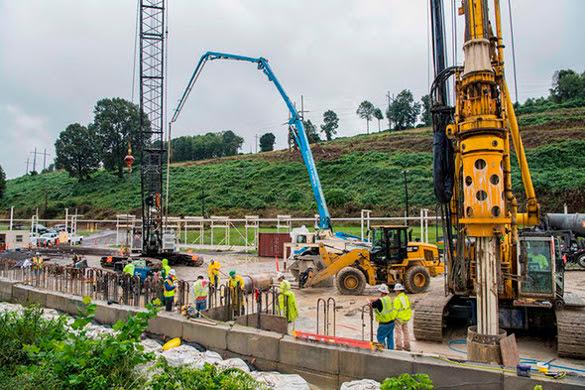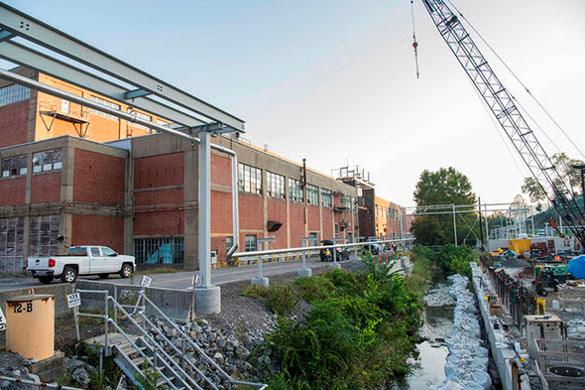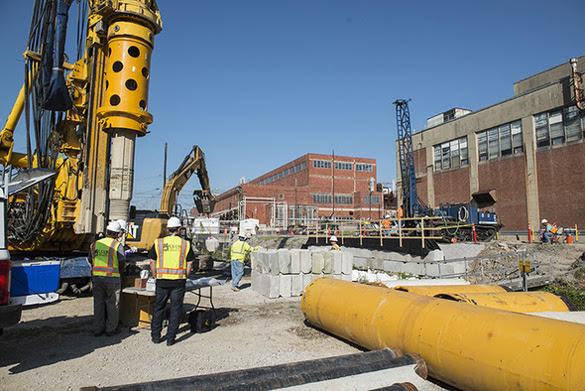 Crews constructed two secant pile retaining walls to retain soils, control water seepage, and provide a deep, secure foundation for the water intake structure. Courtesy photo
Crews constructed two secant pile retaining walls to retain soils, control water seepage, and provide a deep, secure foundation for the water intake structure. Courtesy photoDOE News:
OAK RIDGE, Tenn. ― DOE’s Oak Ridge Office of EM (OREM) has completed site preparations necessary to begin construction of the Outfall 200 Mercury Treatment Facility.
This vital piece of infrastructure will help fulfill OREM’s regulatory commitments to reduce mercury levels in the East Fork Poplar Creek and enable large-scale cleanup and demolition to start at the Y-12 Natonal Security Complex (Y-12).
Mercury cleanup is EM’s highest priority at Y-12. Operations used large amounts of mercury during the 1950s and 1960s, and a portion was lost into the environment. When complete, the new facility opens the door for demolition of Y-12’s large, deteriorated, former mercury-use facilities and soil remediation beneath those buildings.
Outfall 200 is a location at Y-12 where the headwaters originate for the Upper East Fork Poplar Creek, and where the storm drain system discharges from the mercury-contaminated area of the site.
UCOR, Oak Ridge’s lead cleanup contractor, began work on the treatment facility with a subcontractor a year ago following a groundbreaking event attended by Sen. Lamar Alexander and Rep. Chuck Fleischmann of Tennessee, Deputy Energy Secretary Dan Brouillette, and other top DOE and state officials.
The treatment facility will be comprised of two components — a headworks facility and a treatment plant connected by a pipeline. The headworks facility will capture creek flow on the west end of Y-12, store excess stormwater collected during large rainfalls, remove grit, and pump water through the pipeline to the treatment plant on the east side of Y-12. The treated water will then flow into the East Fork Poplar Creek.
Site preparation reduced risks for the construction project, as crews routed mechanical and electrical utilities to the site boundaries, removed small structures in the area, and cleared vegetation along creek banks.
At the future headworks site, teams re-routed a steam condensate return line, demolished abandoned concrete structures, and installed two retaining walls.
The south secant pile retaining wall consists of 65 piles installed at depths of 20 to 40 feet. The north wall consists of 19 piles drilled approximately 16 feet deep.
These walls will retain soils, control water seepage, and provide a deep, secure foundation for the water intake structure to divert Upper East Fork Poplar Creek waters into the headworks portion of the facility.
This week, EM continued moving forward with the project by awarding a four-year $92 million contract for construction to begin in early 2019. Once operational, the treatment facility will have a treatment capacity of 3,000 gallons per minute and a 2-million-gallon storage capacity.
 A view of the Outfall 200 area, where the headwaters originate for the Upper East Fork Poplar Creek. Courtesy photo
A view of the Outfall 200 area, where the headwaters originate for the Upper East Fork Poplar Creek. Courtesy photo Employees dug up to 40 feet in the ground in some cases to pour concrete for the retaining wall. Courtesy photo
Employees dug up to 40 feet in the ground in some cases to pour concrete for the retaining wall. Courtesy photo
